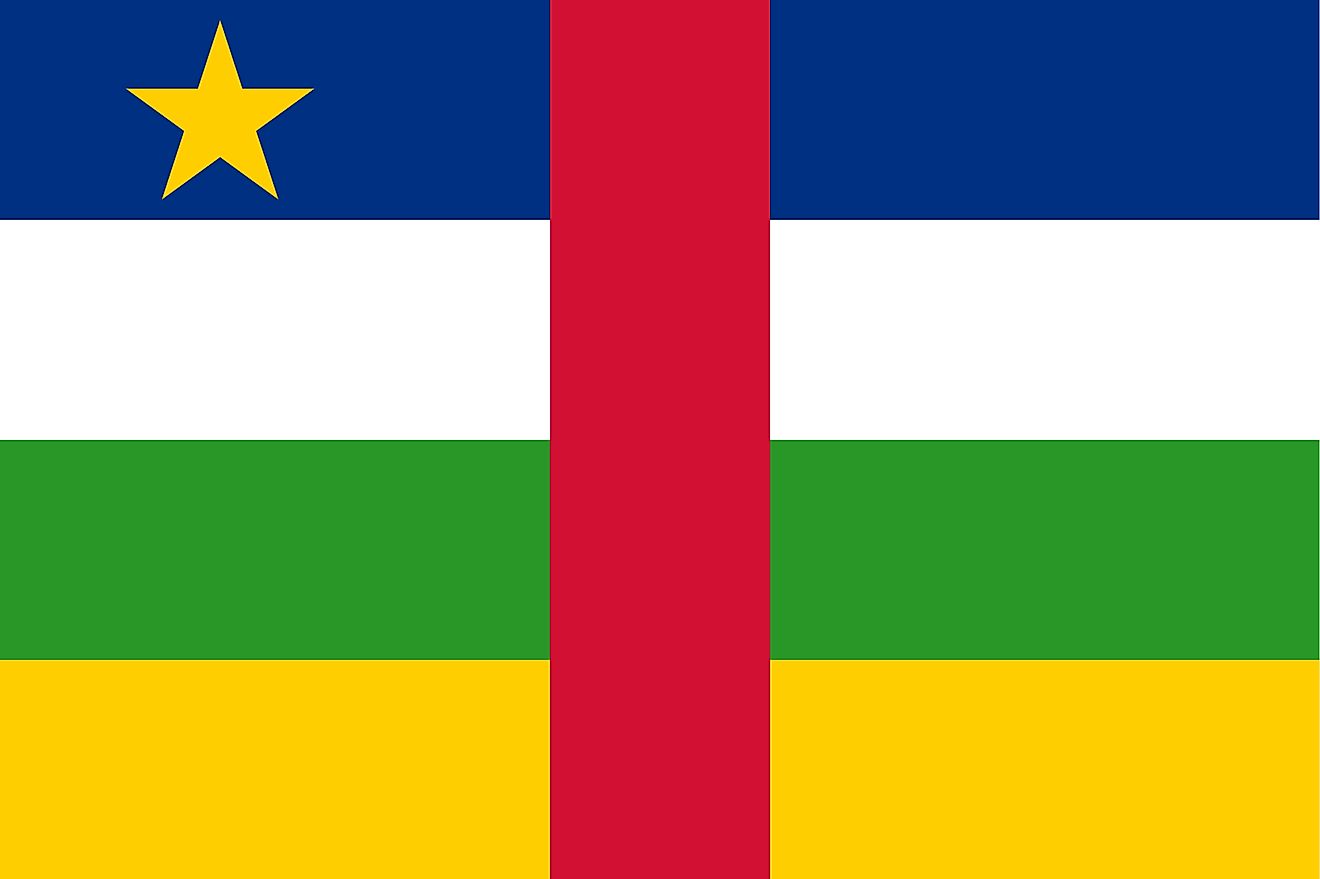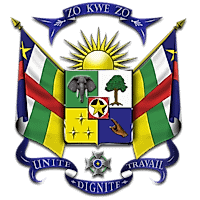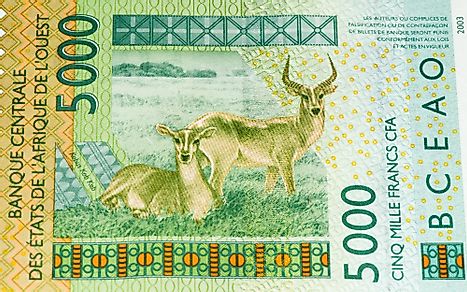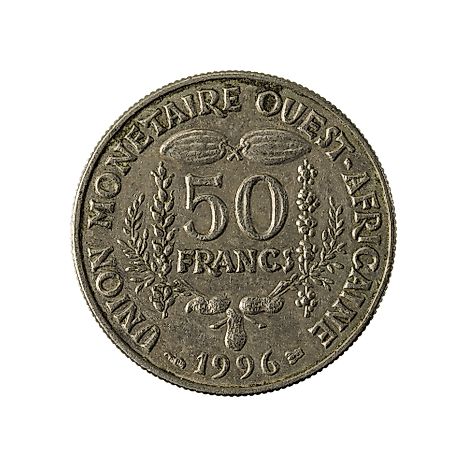Flags, Symbols & Currency of Central African Republic

The National Flag of the Central African Republic was officially adopted on December 1, 1958. The flag has been designed by Barthelemy Boganda.
The National Flag of the Central African Republic features four equal horizontal bands of blue (top), white, green, and yellow with a vertical red band in center. A yellow five-pointed star is positioned in the hoist side of the blue band. The flag is a combination of the Pan-African flag and the French flag colors. The red color represents the blood of humanity and symbolizes the respect that Europeans and Africans have for each other. The blue color represents the sky and freedom; the white color symbolizes peace and dignity; the green color represents hope and faith and the yellow color stands for tolerance. The five-pointed yellow star of independence represents the aspirations of the country towards a vibrant future. The flag has a width-to-length proportion ratio of 3:5.
History of the Flag of the Central African Republic
Being a French colony, the Central African Republic used the National Flag of France as their official flag. In 1958, when the country became an autonomous territory from a colony, the first flag was created and started to be used. This flag was subsequently confirmed as the national flag of the country and has not undergone any further changes ever since.
Symbols of Central African Republic
The National Coat of Arms of Central African Republic

The Coat of Arms of the Central African Republic was adopted on May 17, 1963. It is composed of a shield that is supported by two flags. The elephant and the baobab tree within the shield are symbolic of nature and represents the backbone of the country. The hand in the shield’s bottom right is a symbol of the MESAN party (The Movement for the Social Evolution of Black Africa). The three diamonds in the shield’s bottom left are symbols of the mineral resources of the country, and the golden star centered above a map of Africa represents the country's position on the continent. There are two white banners: one with ZO KWE ZO = “All people are people”, placed above, and one containing the national motto, placed below the shield. A golden sun rises above the shield, and a medal symbolizing the Order of Central African Merit rests underneath.
National Motto
"Unite, Dignite, Travail" ("Unity, Dignity, Work")
National Anthem
- Anthem Title: "La Renaissance"
- Music Composer: Herbert Pepper
- Lyricist: Barthelemy Boganda
- Date of Adoption: May 25, 1960
"La Renaissance" is the national anthem of the Central African Republic. The music has been composed by Herbert Pepper (a French ethnomusicologist) and the lyrics has been authored by Barthelemy Boganda, the former Prime Minister. The anthem was officially adopted on May 25, 1960.
La Renaissance (French)
Ô Centrafrique, ô berceau des Bantous !
Reprends ton droit au respect, à la vie !
Longtemps soumis, longtemps brimé par tous,
Mais de ce jour brisant la tyrannie.
Dans le travail, l'ordre et la dignité,
Tu reconquiers ton droit, ton unité,
Et pour franchir cette étape nouvelle,
De nos ancêtres la voix nous appelle.
Chorus:
Au travail dans l'ordre et la dignité,
Dans le respect du droit dans l'unité,
Brisant la misère et la tyrannie,
Brandissant l'étendard de la Patrie.
National Anthem of the Central African Republic
Oh! Central Africa, cradle of the Bantu!
Take up again your right to respect, to life!
Long subjugated, long scorned by all,
But, from today, breaking tyranny's hold.
Through work, order and dignity,
You reconquer your rights, your unity,
And to take this new step,
The voice of our ancestors call us.
Chorus:
To work! In order and dignity,
In the respect for rights and in unity,
Breaking poverty and tyranny,
Holding high the flag of the Fatherland.
The Currency of Central African Republic is the The Central African CFA Franc
The official currency of the Central African Republic is The Central African CFA franc.
The CFA franc is issued by the Bank of the Central African States that is located in Yaoundé, Cameroon. Though, the franc has an equal value to the West African Franc, it cannot be used in West Africa. The franc is offered in both notes and coins and is divided into centimes. It is pegged to the Euro at a standard rate of 1 Euro = CFA 655.957.
Coins
Except Cameroon, CFA coins were introduced to all the French colonies in 1948. The first coins were issued in denominations of 1 and 2 francs, but the production of the 2 CFA coin was stopped. The 5,10- and 25-franc coins were issued in 1958 to all the colonies including Cameroon. In 1961 and 1966 the 50 and franc coins were introduced respectively. In 1971, each state introduced the 100-franc coins within their borders; the 500-franc coins were later introduced in 1976. The coins were also introduced to Equatorial Guinea after it adopted the currency. 1n 1996, the production of 100-franc coin was centralized, and in 1998 the Bank of Central African States authorized the production of the 500-franc coin. In 2006, the 2 CFA franc coin was introduced.
Banknotes
When the French introduced the franc, it circulated in the denominations of 5, 10, 20, 100 and 1000 CFA franc. In 1947, a different series of notes that did not bear the name of the colonies was introduced. The 5, 10, 20, 50, 100- and 1000-francs notes were the first to circulate before the 500, and 5000 notes were introduced in 1949 and 1952 respectively. In 1968 the 10,000-franc note was introduced, in 1971 the 100-franc note was withdrawn from circulation and replaced by the 100-franc coin. In 1975, each state began producing their own 500, 1000, 5000 and 10,000-franc notes. However, the independent production ceased in 1993 and the state names replaced by a single letter to distinguish the state where the currency was issued. In 1993, the 2000-franc note was introduced.
Historical Currencies of the Central African Republic
The CFA Franc was introduced in 1945 by the French to its colonies including CAR in Equatorial Africa to replace the French Equatorial African franc. After Independence, the colonies continued the use of the franc. In 1984, Equatorial Guinea replaced its currency the Equatorial Guinean Ekwele when it adopted the CFA franc despite being a Spanish colony.









